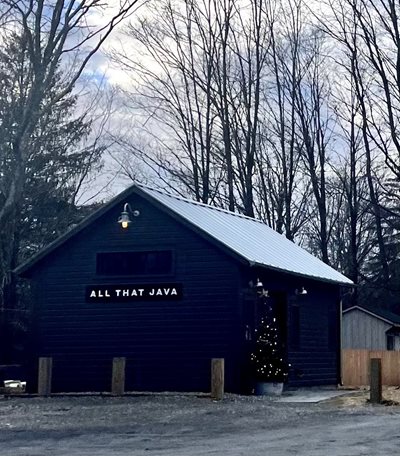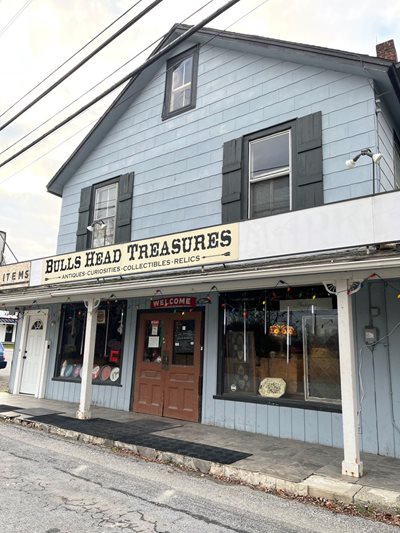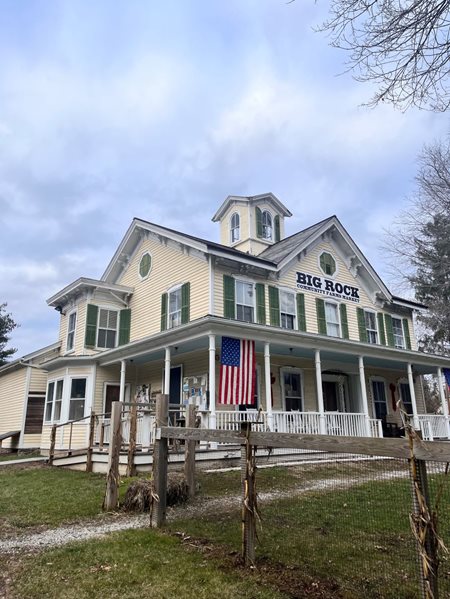When I was a kid, the center of my small, rural, Hudson Valley town featured an ice cream shop with a sticky, walk-up service window and a tiny, one-register grocery store where they carried one of practically everything. Today, the grocery is an antique store, and it sits a stone's throw from a new marketplace that peddles organic, farm-sourced products of a certain aesthetic, accordingly priced. I like the marketplace and support the local purveyors that sell there, but it's a far cry from the dusty grocery that used to meet our daily basic needs.
 On the surface, perhaps my hometown hasn't changed all that much over the years. It's a no-stoplight town with a hodge podge of buildings clustered around a two-lane highway that serves as the main thoroughfare, and it's still a little rough around the edges. Even so, you don't have to dig too deeply to see that changes are afoot, with their steady, inexorable movements reshaping the landscape of the community. Wide swaths of countryside have been molded into estates where extreme wealth lays just behind the hedgerow. Home listings on a single day in December 2023 showed 18 homes for sale, with three priced over $1 million (two of those over $2 million) and six others over $750,000. That organic marketplace? It has stuck around for a few years now, and a new coffee shop just popped up next door. Perhaps most telling, my daughter, age 16, recently pronounced the town "adorable."
On the surface, perhaps my hometown hasn't changed all that much over the years. It's a no-stoplight town with a hodge podge of buildings clustered around a two-lane highway that serves as the main thoroughfare, and it's still a little rough around the edges. Even so, you don't have to dig too deeply to see that changes are afoot, with their steady, inexorable movements reshaping the landscape of the community. Wide swaths of countryside have been molded into estates where extreme wealth lays just behind the hedgerow. Home listings on a single day in December 2023 showed 18 homes for sale, with three priced over $1 million (two of those over $2 million) and six others over $750,000. That organic marketplace? It has stuck around for a few years now, and a new coffee shop just popped up next door. Perhaps most telling, my daughter, age 16, recently pronounced the town "adorable."
The Hudson Valley has always attracted people seeking a place to get away from it all. It's got everything it needs to meet that desire: bucolic landscapes, food with a farm-fresh allure, and a two-hour commute to mid-town Manhattan. I'm not surprised that folks love it. But the changes that have been slowly taking place over the past decades in havens like this were dramatically accelerated by outmigration during pandemic. And that's leaving places like my hometown — and the regular folks who live there — in a race to keep up.
Across the country, similarly-situated communities — rich in outdoor, recreational resources and close to urban centers — are facing the same challenges. Whether people are moving out of cities to the wide-open spaces of the west, relocating to bucolic towns in the New Hampshire hills, or popping up to the Hudson Valley from NYC, rural communities near natural attractions such as ski resorts, farms, lakefronts, and the like, have seen large increases in population driven by the pandemic, and by the ability for more people to work "from anywhere."
These population shifts are stressing a market that already has a limited — or non-existent — supply of affordable homes, and despite being in the "post-pandemic" era, the changes in rural communities seem to be sticking.
So what lessons can rural communities like these learn from the past few years? How can they balance the economic shifts with the need to increase affordable housing supply? And how can we preserve the places we love and still get to share them with others?
the economic shifts with the need to increase affordable housing supply? And how can we preserve the places we love and still get to share them with others?
Perspectives across the network
For some perspective, I talked to folks in the NeighborWorks network who are working across these issues. NeighborWorks has a decades-long history of building capacity in its rural organizations, which comprise approximately half of the network. Although these conversations took and are taking place in communities across the country, a few common themes were clear.
We can't shy away from involving people in conversations about change, especially when those conversations are difficult. In rural places and small towns, getting a variety of perspectives can be challenging, but we need to be intentional and direct in engaging people to develop plans and strategies for the long-term sustainability of the places we love. In doing so, we create transparency and build trust, two critical building blocks for effective collaboration.
Those working in the housing and economic development sectors need to come together more frequently, and they need to create coordinated strategies. Too often, the institutions in these sectors operate in siloed ways that reinforce outdated and ineffective approaches. Despite the "live, work, play" mantras that subtitle many planning efforts, these concepts too infrequently show up as coordinated strategies.
We need to unpack the concept of density in real terms that address the underlying fears and inequities that undercut zoning shifts that could support affordable housing. Zoning is one of the most important tools we have to manage community change. Density done right preserves open space, creates more vibrant town and village centers, and can actually maintain the character of the places that we love.
Bridging the housing and economic development sectors
Javier Gomez is director of community development and impact at Hudson River Housing. He's lived in the Hudson Valley since first grade and can't imagine calling any other place home.
"I just love it here!" he says. "It's a really great place to live. Not a lot of places have the mix of amenities that we have here." Gomez takes the long view and isn't surprised by the changes he sees coming to his community. "People found us, is how it feels."
For Gomez, the pressures of being in close proximity to New York City can't be denied. "I see how built-up parts of Westchester are, and I think, is that the future of the Hudson Valley?" As the last stop on the commuter rail, Dutchess County in the mid-Hudson Valley has long served as a bedroom community for New York City. Gomez sees the tight housing market as inextricably linked to the magnetic pull of NYC as a jobs center, just a two-hour drive or train ride away. He believes that until there is a stronger local job market, which would give people more breathing room regarding where they can live and still have a reasonable commute, the mid-Hudson Valley is going to continue to ebb and flow in concert with NYC. "Our towns and villages have to become hubs of jobs too," he says. Having the well-paying jobs located only in NYC puts "too much pressure on the housing market."
The connection between the housing market and economic development was a common theme in my conversations. Peter Hainley, executive director at CASA of Oregon, has lived in the state his whole life. "Oregon's beautiful, a land of plenty. When you fly into Portland, you're like, wow. You can understand why people want to move here... There's a lot of good stuff here for folks that are looking for a good quality of life."
That said, the growth has been exponential. "It's unrecognizable from the state of my youth," says Hainley, who has seen people moving to small towns from urban centers. As more people come seeking services and amenities — and put pressure on those who already exist — there's a gap. That means a heavier lift for communities to provide the quality of life that gave people a reason to relocate in the first place. "Employers are getting in the conversation about affordable housing more, but it's kind of tangential — they're not driving the conversation," says Hainley. "There's a role for somebody to get businesses more involved. I don't know what that looks like, but it would be advantageous to all of us that work in this field."
 Carmen Lorentz, executive director at Lakes Region Community Developers in New Hampshire, agrees. She has watched changes unfold in her hometown over time, with the pace quickening in recent years. "Everyone complains about workforce housing, but I haven't seen anyone doing much about it," she says. "A lot of the products that people need — like seasonal housing — can't be built with current government tools."
Carmen Lorentz, executive director at Lakes Region Community Developers in New Hampshire, agrees. She has watched changes unfold in her hometown over time, with the pace quickening in recent years. "Everyone complains about workforce housing, but I haven't seen anyone doing much about it," she says. "A lot of the products that people need — like seasonal housing — can't be built with current government tools."
Instead, developers are catering to a luxury market, one led by the people relocating to the region. "When I was younger, people could have a lake cabin or cottage; it wasn't unusual. When I was in college, I started seeing huge mansions being built on the lake. Most of the lakefront property has been consumed at this point. Now, we're seeing them spreading out into non-lakefront properties, definitely catering to people that want a second home to not be in the city."
In a place where year-round workers already struggled to find affordable housing, the pandemic really saw things explode. And the dynamic doesn't appear to be changing much. "Folks are here to stay," says Lorentz. "Maybe they're not here quite as much as they were, but they're keeping the house here."
The potential for density
All of the people I talked to agree that change isn't necessarily negative. "It's not all bad, and it's not all good," says Gomez. "You can't really preserve something entirely. That's just life. People come in and they change things." And that doesn't just mean more high-end housing; the need for greater housing affordability changes things, too.
Network leaders agreed that greater housing density is one of the keys to both increasing affordability and preserving local character. By building more intensely in existing town and village centers, housing stock can increase in ways that feel more natural, doesn't depend on sprawl development to meet the need for more units. "Density is not a bad thing," says Gomez. But it can be hard for people to reconcile more density with the goal of preserving small town life.
Sarah Kackar, director of Rural Initiatives for NeighborWorks America, emphasizes the importance of cross-sector collaborations to moving the needle on density. "Community members, local elected officials and volunteer board members need to work together to build an understanding of how density around the rural main street core is critical to ensuring land development policies allow a more concentrated development pattern in rural downtowns," she says. "Comprehensive plans, small area plans, and zoning ordinances should reflect the ability to densify rural main streets in a manner that also results in preserving the rural character."
Available and properly zoned land for affordable housing is an issue in rural areas, says Hainley. "Finding multi-family zoned land can be very difficult in many rural communities. And once you find it, getting utilities to the site can be a real chore." Last year marked the fiftieth anniversary of Oregon's Land Use Planning Program. Today, says Hainley, more and more communities in Oregon are allowing denser housing through the use of cottage clusters and accessory dwelling units, and the Oregon legislature has been active in promoting increased density.
"The density question is huge and so hard for people to wrap their heads around," says Lorentz. "But if we can build more dense housing in place that can accommodate it, that's a big piece of [the solution]."
Tough conversations
Combine that with a really intentional approach to involving residents in the decision-making process, and we'd be moving in the right direction. "If communities are having conversations about affordable housing, but it's always people like me acting as representatives, and we're never actually doing the engagement with the actual community members, that's a problem," says Hainley.
Gomez concurs. "When it comes to preserving our culture, that has to be really intentional. It's hard work. You have to really care about it. There're always things we can do to make sure people are represented and not forgotten."
Broad resident and stakeholder engagement is critical in housing discussions and decision-making. According to Kackar, a broad representation of permanent and part-time residents, long-time and new community members, local officials, private businesses, nonprofits and elected leaders should be at the table. Discussing how the community's vision for the future matches with land development regulations and available resources will help in finding common points of interest for all parties to move forward.
The way we go about engagement has to be practical too. "Housing pulls at the fabric of our communities, but people who live here part time and somewhere else part time don't really get involved, and I think then you have the people who are here year-round who are so housing cost-burdened and working so much that they also aren't volunteering or serving on boards," says Lorentz.
Comprehensive community development approaches
There are no simple answers. But one thing that can help is a framework for a comprehensive, layered approach that balances urgency with the long view. NeighborWorks' approach to comprehensive community development does just that. It is built on the experience of our network of organizations and people like Gomez, Hainley and Lorentz, who are engaged in on-the-ground work every day.
NeighborWorks' comprehensive community development approach provides a roadmap of seven core principles that can help communities get it right by fostering change in an incremental and accessible way that leads to long-term improvement — and do so in a way that brings people together instead of deepening divides. It also reflects the complexities of place and the need to tailor strategies to a communities' distinctive makeup. And, by emphasizing interconnected strategies, comprehensive community development also helps people see the big picture — and their individual place in it.
This perspective is more critical than ever if communities are to effectively tackle the challenges before them today. Says Gomez, "For people who care about [the places where we live] we have to be more active, more engaged with the things that matter to us. Change is inevitable — we just have to figure out what's our place in it."
01/09/2024

